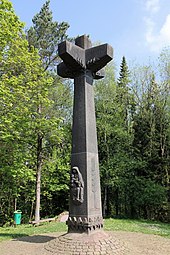Explosion disaster in Prüm
During the explosion in Prüm on July 15, 1949, an ammunition dump detonated in the Kalvarienberg north-west of Prüm in the Eifel . The cause of the explosion , in which the city was badly damaged and 12 people killed, could never be clarified. The explosion crater visible to this day is one of the largest that was caused by human hands. A memorial cross on the Calvary commemorates the victims of the disaster.
history
When the west wall was built in 1939, a standby bunker of the Wehrmacht was built in the Kalvarienberg . The hollow aisle bunker was 20 to 30 meters deep under the hilltop and consisted of a 100 and a 60 meter long tunnel. After the Second World War , the French occupation army deposited 500 tons of ammunition there, which was to be used to blow up the Siegfried Line fortifications. The population of Prüm knew about this storage and was concerned about it.
On July 15, 1949, there was a fire in the bunker. The Prüm volunteer fire brigade triggered the fire alarm shortly before 7 p.m. and tried to extinguish the fire, but could not get into the deep tunnel to the source of the fire . They succeeded in withdrawing them in time and evacuating large parts of the population from Prüm , which saved many lives. The ammunition dump exploded at around 8:22 p.m. 250,000 m³ of stones, earth and debris from bunkers were thrown into the air and fell on Prüm. Twelve people were killed, 15 people seriously or slightly injured, and 965 people became homeless. The water supply collapsed, the telephone lines and some of the road connections were completely destroyed. The hospital, school and post office, as well as numerous residential buildings, were in ruins. The explosion crater was 190 × 90 meters in size and over 20 meters deep. The explosion was even registered by earthquake control centers .
This was the second destruction of Prüm in a short time, after 92 percent of the city had been destroyed by air raids and ground fighting in World War II. Since Prüm had not been completely rebuilt by 1949, 900 of its previous residents still lived outside the city.
After the explosion, the Luxembourg army from the garrison in Bitburg and the French army with medical departments came to the aid of the city. The fire brigades and Red Cross teams from all over the Eifel as well as from Koblenz and Neuwied were also involved in the rescue operations . Prime Minister Peter Altmeier and Minister Johann Junglas hurried to the disaster area that night. The participation of the country was very great and so the city could be rebuilt with the help of donations .
The cause of the accident that wreaked havoc in and around Prüm could never be clarified. The presumption that it was an act of sabotage persisted even 60 years later in parts of the population. At the end of the 1990s, Defense Minister Rudolf Scharping and the French National Archives tried to find an explanation without success.
On the Kalvarienberg a seven meter high memorial cross made of basalt, created by the artist Johann Baptist Lenz from Oberkail , has been commemorating the catastrophic explosion since 1979 .
See also
literature
- H. Bonus: Memories of the explosion in Prüm 40 years ago in: Heimatkalender Landkreis Bitburg-Prüm 1989, ed. from the Bitburg-Prüm district administration, pp. 54–56, Trier 1988.
- E. Urbanus: How I experienced the explosion in: The Prümer Landbote. Journal of the history association "Prümer Land". The Prümer Land in past and present, 24/89, p. 160, Prüm 1989.
Web links
- July 15, 1949. The disaster of explosion in Prüm. in: State Main Archive Koblenz
- And then it got dark ... in: Trierischer Volksfreund weekend journal, 11./12. July 2009
- Explosion catastrophe in Prüm in: pruemnetz.de
- Interview by Manfred Trost with a contemporary witness
- Wolfgang Brenner: When heaven cried “bloody tears” in Der Spiegel on July 15, 2019
Coordinates: 50 ° 12 ′ 37 ″ N , 6 ° 24 ′ 35 ″ E



